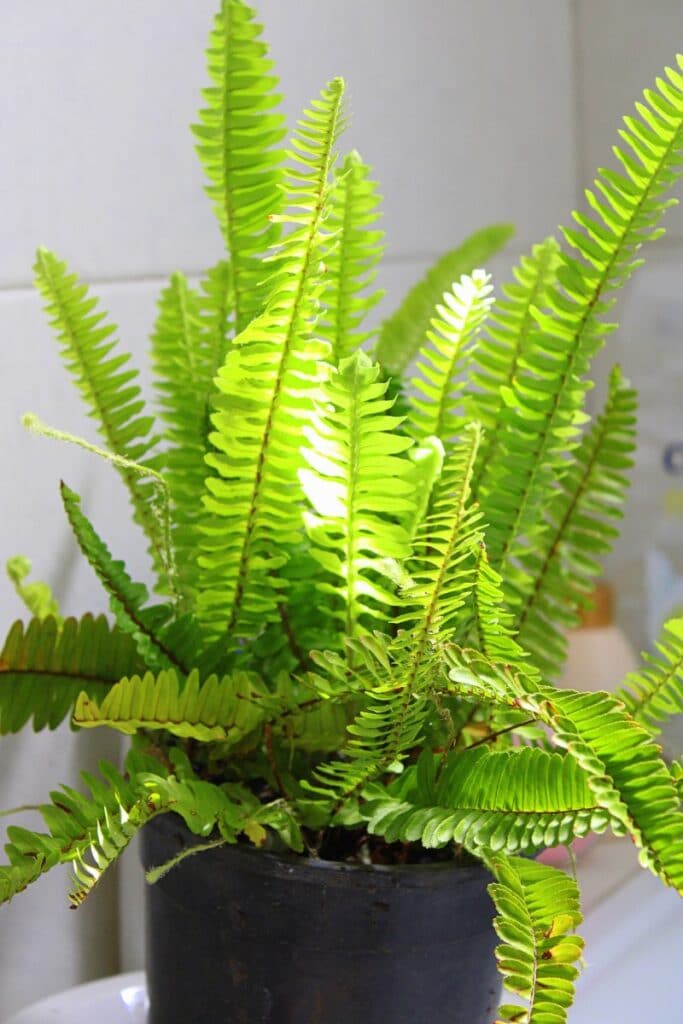Are you interested in learning how to grow and care for the Boston fern (Nephrolepis exaltata ‘Bostoniensis’)? If so, this article will provide you with all the information you need to take care of this popular indoor plant.
Also known as the sword fern, this plant in the family Lomariopsidaceae is native to tropical forests and swaps in South and Central America along with Florida, the West Indies, Africa, and Polynesia. It is commonly grown as a houseplant, featuring medium green fronds.
Of course, you don’t have to grow this fern inside. If you live in USDA zones 9-11, this plant can be planted directly into the ground. At up to three feet tall and wide, though, it can really sprawl – so be sure to give it plenty of space.
Most growers tend to grow Boston fern as a houseplant, though, since this will allow you to grow it as a perennial no matter where you live. Here’s what you need to know.
Plant Facts
| Scientific name | Nephrolepis exaltata ‘Bostoniensis’ |
| Common names | Boston Fern, Sword Fern |
| Family | Lomariopsidaceae |
| Plant Type | Houseplant |
| Height and Width | 1-3 feet tall (indoors), 2-3 feet wide (indoors) |
| Origin | Mexico, northern South America, Florida, West Indies |
| Flower colors | None |
| Foliage color | Medium green |
| Sun Exposure | Bright, indirect sunlight |
| Soil Type & pH | Well-drained, slightly acidic |
| Special features | Low maintenance, good for containers, easy to propagate by division |
How to Grow Boston Fern
Hardy outdoor ferns in zones 9–11, this plant is most commonly grown in pots indoors. It sends out long, thin runners which root to form new plants when they touch the ground. This causes the plant to develop a broad, bushy form when grown in a pot.
Use your Boston fern as a houseplant accent. You can plant Boston ferns on a plant stand, in a raised container, or in hanging baskets. Doing this will offer a dramatic visual effect with cascading foliage that looks like a fountain.
You may also choose to combine your potted fern with other attention-grabbing plants such as caladium, coleus, or browallia. Impatiens and begonias make great companions, too, as do other colorful flowering annuals when you move the plant outside in the warmer months.
To plant, simply begin by filling a container with two to three inches of fresh potting soil. With your potted boston fern grasped gently in one hand, tilt the pot and guide the plant carefully into the container. Fill in around the root ball with potting soil, up to about one inch. Tap down, then water deeply. That’s all there is to it!

Propagation
Boston ferns are incredibly easy to propagate by division. Some gardeners choose to propagate from spores, but named cultivars won’t grow true and it is often much easier to just divide the plants. Do this every few years.
This should be done in the spring. Simply snip off a small section of the fern’s rootball with a few healthy roots still attached. You don’t need to take a very large cutting – even very tiny cuttings can become established as new plants.
Place the cutting in a container with moist potting soil, burying about half of the cutting in the soil. Keep the soil lightly moist at all times, with each container in a warm spot away from temperature fluctuations and drafts. It should receive sunlight but be out of direct sunlight.
After two to three weeks (sometimes a bit more), you should feel resistance by gently pulling on the base of the fronds. This is how you will know that your cutting has set roots. It is now ready to be transplanted by following the steps above in the planting section.
Soil
Boston ferns perform best in rich soil with regular fertilization (more on this below). Choose a well-draining, nutrient-rich soil or potting medium such as a combination of vermiculite and peat.
Pruning
As low maintenance indoor plants, pruning is not necessary but it can help your plant maintain a tidier, more attractive overall appearance. Simply cut the old and dead fronds off at the soil line. This will encourage the growth of new fronds.
Repotting and Transplanting
Boston ferns should be repotted when you notice the roots poking out of the soil. This is an indication that the plant has grown too big for its current environment and needs to be moved.
Another indication that the plant needs to be repotted is when it stops growing as vigorously as it was before.
To repot, simply select a container that’s one size (a few inches in diameter) bigger than the pot you already have. Gently remove the plant from the old container and replant it at the same depth in the new container but with fresh potting mix.

Boston Fern Care Tips
Here are some tips to help you care for this evergreen houseplant.
Water
The Boston fern plant prefers soil that is consistently moist. Water when the top inch of soil is dry (about one to two inches of water per week).
If you use tap water, let it sit out for 24 hours before watering your plants. This plant’s fronds are sensitive to salt impurities that are often found in tap water, which can lead to root rot.
Sunlight
Provide full to partial shade if you grow your Boston ferns as outdoor plants. But when growing Boston ferns indoors, bright, indirect light is ideal.
You can place your plant in a south- or west-facing window or behind a sheer curtain. This will help prevent the foliage from being scorched by too much sun.
Temperature and Humidity
During the day, Boston ferns prefer temperatures of no more than 95 degrees Fahrenheit, but at night, the temperatures can be as low as 65 degrees. This makes the indoor temperatures of a home ideal for this plant.
It can occasionally tolerate cooler temperatures but not for prolonged periods of time. If you bring your plant outside for any reason, bring it back inside or protect it from frost once temperatures dip below 45 degrees.
Humidity is essential for this fern. It can be drought-tolerant, but it’s important to make sure its foliage has access to humidity. You can double-pot, which is the act of placing a fern within its pot inside a second, larger container lined with moist sphagnum moss or rocks. You can moisten the medium or rocks often, which will help retain humidity around the plant without oversaturating the roots of the plant.
Keep your plant away from drafts, as this can cause it to dry out more quickly.
Fertilizer
This plant is one that does best with regular fertilization. You can use a liquid or slow-release fertilizer meant specifically for houseplants, diluted at half strength. Apply this every four to six weeks during the active growth period. During the winter, you can stop fertilizing entirely.
Keep a close eye on your plant to make sure you are not over-fertilizing it. The most common sign of too much fertilizer will be brown, dry frond tips.
Pest and Diseases
There are few diseases and pests to which Boston fern is prone. The most common pests are mealybugs and scale insects, which are common indoor ferns pests. You can avoid these by keeping your plant adequately watered and fertilized. Removing affected fronds can also be helpful.
Though not a true disease, the most common problem you are likely to have with your Boston fern plants has to do with a lack of humidity. When you grow this humidity-loving indoor fern, it may develop dry-looking pinnae. Simply clip these off and continue watering your plant as normal. However, you should add regular misting to your daily routine to keep the plant adequately humid.
Common Varieties and Cultivars
There are a few common types and cultivars of Nephrolepis exaltata that you can grow besides ‘Bostoniensis,’ including ‘Compacta,’ ‘Dallas,’ and ‘Florida Ruffle.’
Other related sword ferns include:
- ‘Fluffy Duffy’
- ‘Fluffy Ruffles’
- ‘Golden Boston’
- ‘Massii’
- ‘Rita’s Gold’
- ‘Roosevelt Ii’
- ‘Verona’
- ‘Whitmanii’
FAQs
How much sun does a Boston fern need?
Boston ferns thrive in bright, indirect light but can tolerate lower light conditions.
How often do you water a Boston fern?
Water Boston ferns thoroughly when the top inch of soil feels dry to the touch, typically every 1-2 weeks.
How do I keep my Boston fern happy?
To keep your Boston fern happy, provide it with consistent moisture, moderate temperatures, and protection from drafts. Additionally, ensure it receives regular fertilization, pruning, and occasional misting for increased humidity.
Are Boston ferns toxic to pets?
No, Boston Ferns are non-toxic to pets, including cats and dogs. According to the American Society for the Prevention of Cruelty to Animals (ASPCA), these ferns are safe to have around the house. While they improve air quality and humidity, it’s essential to prevent pets from consuming large amounts of the plant.
Conclusion
So there you have it! Everything you need to know to grow Boston fern plants indoors. These plants grow quickly and spread rapidly, so be sure to set aside the perfect corner of your home to grow them. They’re sure to brighten up any space!






